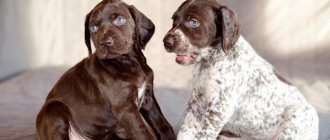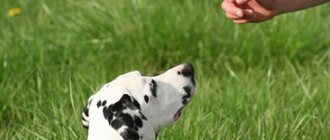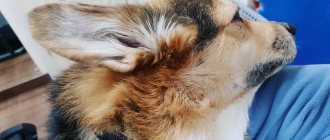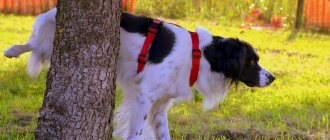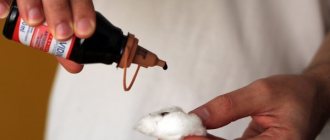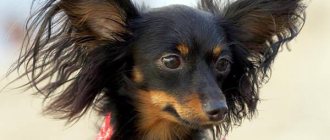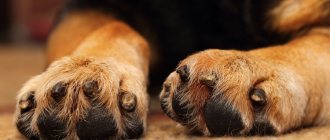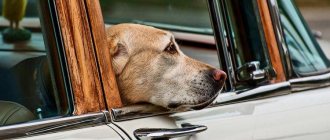Origin story
The German Shorthaired Pointer (other names: German Pointer and German Shorthaired Pointer) is a hunting dog breed developed in the 19th century in Germany. Belongs to the group of cops. The name means short-haired (from German kurz - short and haar - wool, hair). Scientists do not know exactly how the breed developed. It is known that cops were common in the Mediterranean several thousand years ago. Then they settled throughout Europe and began to be actively used as hunting dogs. They took part in falconry and capturing animals.
Cops have the ability to silently sneak up on prey and take a special stance, showing the location of the animal. After the invention of firearms, this skill acquired particular value.
Over time, pointers became excellent gun dogs, and many European countries began breeding national species. This is how the division into island and continental cops occurred. It is expressed in different functionality and hunting conditions. Continental varieties, to which the shorthaired pointer belongs, are considered universal.
Scientists believe that the ancestors of the Kurts were cops originally from Flanders. After their resettlement in Germany, they began to actively crossbreed with the native hounds and Perdigeros de Burgos (a Spanish breed of hunting dogs). This led to the emergence of the Württemberg Cop. Pointer blood began to be added to the breed, resulting in the appearance of German Shorthaired Pointers. Close relatives include the langhaar and the drathaar.
The breed was recognized by the FCI in 1954.
Hunting with shorthaired pointer
Initially, this breed was actively used in hunting waterfowl. The main task of the shorthaired pointer was to deliver shot game to the owner from the water or swamp.
The German Shorthaired Pointer is a versatile hunter. On any terrain, in any conditions and even for any game. This is why European hunters respect her so much.
IMPORTANT. Despite the innate instincts of a hunter, skills will not appear immediately, but will increase gradually, with each subsequent hunt.
There are two main types of hunting with shorthaired pointer: birds and animals.
Bird hunting
Due to the ability to quickly navigate the terrain and agility, the breed is considered an ideal companion when hunting waterfowl, as well as wood grouse and pheasants.
When a bird is found, the pointer freezes in its stance, thereby allowing the hunter to prepare for the shot. Having waited for the command, the shorthaired pointer “lifts” the bird, after which the hunter shoots. The dog easily finds and brings prey to the owner.
In the case of quail hunting, the pointer often catches the bird herself. This is especially appreciated when the quail does not try to fly away, but runs away along the ground.
Hunting the beast
Suitable for hunting both wild boar and hare. In both cases, the Shorthaired Pointer is very successful.
When hunting a wild boar, it tracks the game, after which it uses its voice to indicate the location of the prey and leads the hunter to shoot.
Hare hunting is characterized by increased concentration. In this type of hunting, the dog’s task is to find the game and “pick it up” correctly. Driving by barking, as is the case with large game, is not advisable. Kurtz must, on command, raise the hare and not try to chase it, in order to allow the hunter to calmly aim and shoot at the prey.
Such obedience is difficult to achieve, but it is possible. As a result, the hunter will receive an ideal companion, with whom no hunt will be complete without prey.
IMPORTANT! During a hunt, a dog is subjected to serious physical stress. In order to protect your pet from unwanted injuries or illnesses, it is necessary not to get too carried away with the process and give the shorthaired pointer a little rest. And for additional security, use a special protective overalls for hunting dogs.
We invite you to familiarize yourself with: German boxer dog. Description, features, care and price of a German boxer
Description of the breed
The Shorthaired Pointer is a large, short-haired dog with floppy ears and a slender build. It is distinguished by a wide palette of colors and varied spots.
Breed standard:
- Dimensions: height up to 66 cm, weight up to 32 kg.
- The head is elongated, of good proportions. The skull is wide, the forehead is convex. The muzzle is powerful with developed jaws. The jaws have a strong grip. Full set of teeth.
- The nose may be upturned or downturned. There is a soft hump on the bridge of the nose. The nose is large, with wide open nostrils. Its color is brown.
- Eyes of medium size. The iris is colored brown or shades of yellow. A light iris is acceptable, but not desirable.
- The ears are hanging, set high, and fit well to the cheekbones.
- The neck is long, muscular, and gracefully proportioned.
- The body is strong, square in outline, and properly balanced. The belly is dry and lean. The chest is set deep. The back is straight and strong, with a sloping loin.
- The limbs are straight and muscular. Hips are dry and wide. Paws can be round or oval.
- The tail is thick at the base, gradually tapering towards the tip. Can be docked by half or two thirds.
The shorthaired pointer's movements are fast and energetic. While searching for game, it moves at a short gallop, which is replaced by a fast trot.
Colors
The German Greyhound is distinguished by its spotted coat. Stains can come in all shapes and sizes, from large marks to tiny splashes.
Kurts have the following color options:
- Brown. The color may be plain or with subtle splashes of white on the chest and limbs.
- Brown roan. It is a mixture of white and chocolate in a 1:1 ratio.
- Light brown roan. Specks of white predominate.
- White. The body is painted white, with brown markings on the head. Speckling is allowed on various parts of the body.
- Black. May be accompanied by yellowish spots or a white star-shaped marking on the chest area.
- Black and white. Black with spots of different sizes.
There is an opinion that the color with yellow tan is characteristic of chickens who are good at taking a blood trail.
The shorthaired pointer is a wire-haired dog with coarse, bristly hair. The hair in the head area has a softer structure.
Appearance of shorthaired pointer dogs
The shorthaired pointer is a large dog. The height at the withers of some males reaches 66 cm, but the physique is elegant and even graceful. Despite the fact that the body is muscular and athletic, the dog looks light. And the weight of a shorthaired pointer rarely exceeds 32 kg, and females weigh 20-27 kg. Therefore, it is classified as a medium rather than large breed.
The standard provides for the following features of the Shorthaired Pointer:
- elegant harmonious physique;
- pronounced muscles;
- short smooth coat;
- long muscular legs;
- dry head with long floppy ears;
- stately posture;
- easy free movements.
The dog's working qualities, balanced temperament, and lack of aggression are most valued. Individuals that do not pass the tests are not allowed for breeding.
Photos complement the description of the appearance:
Head
The head is wedge-shaped, dry, and proportional in size to the body. The skull is wide, rounded, the forehead is convex. The brow ridges are clearly visible, and the stop and occipital protuberance are almost invisible. The muzzle is wide, elongated, gradually tapering towards the nose. It is deep, which makes it easier for the dog to carry game.
The bridge of the nose has a small hump. The lobe is wide, black. But it can be dyed to match the color of the wool. In individuals with a predominance of white color, incomplete pigmentation is possible. The lips are dry, dark, and tightly fitting. A fold is formed at the corners of the mouth. Jaws with a scissor bite, teeth tightly closed, large.
The eyes are medium in size, set slightly askew, brown in color. The look is smart, attentive. The ears are flat, hanging, set high and wide. The size is medium, the tips are rounded, reaching the corners of the mouth. When at rest, the ears are close to the head.
Body type
The physique is harmonious, muscular, the bones are strong, but not heavy. The length of the body is slightly greater than the height at the withers. The neck is long and beautifully curved. The scruff is well defined, there is no dewlap at the throat. The chest is deep, the ribs are arched, the stomach is tucked.
The back is straight and muscular. The loin is short, the croup is wide. The tail is thick at the base and continues the line of the back. Tapers towards the tip, hangs down when calm, reaching the hock joint. It should not rise above the back or bend too much. If the dog is used for hunting, it is recommended to dock the tail at half its length, but in some countries this procedure is prohibited.
Limbs
The limbs are parallel, smooth, muscular. The shoulder blades fit tightly to the body, the elbows are located at the level of the sternum, deep under the body. The joints on the hind limbs are clearly defined. The hips are wide, the legs are long.
The paws are arched, with large claws. The fingers are gathered into a ball, the pads are hard. The movements are sweeping, light, and a proud posture is maintained.
Coat and color
The dog's skin fits tightly and does not form folds. The coat is short - up to 2 cm long, on the head - up to 1 cm. The hairs are hard, reminiscent of bristles, on the head - softer. The coat evenly covers the entire body, lies tightly, smooth and shiny. This is the main difference from its related breed, the Drathaar.
The standard allows several colors. They are usually mottled in color with a black, gray or chocolate tint. The brown shorthaired pointer can be solid, gray, white or gray spotted. With a speckled color, the head is chocolate, large dark spots on the body. Solid brown or piebald colors are acceptable.
The same color options with black. A pure white shorthaired pointer is not recognized as a purebred shorthaired pointer; it must have chocolate or black spots and spots. German breeders prefer darker browns, contrasting colors, as such dogs are more noticeable when hunting.
Photos of shorthaired pointers of different colors:
Disqualifying faults
The standard for this breed has been revised many times; the version from 2001 is currently in effect. He describes in detail what a shorthaired pointer should look like. Any deviations from the standard are unacceptable. Dogs with the following defects and defects in appearance are not allowed for exhibitions and breeding:
- malocclusion;
- short or pointed muzzle;
- incomplete dental formula;
- fleshy lips;
- light eyes;
- short or narrowly set ears;
- pronounced stop;
- wavy coat;
- pendant around the neck;
- hunched back;
- incorrect placement of limbs;
- curving tail;
- ambling or clumsiness in movements.
Character and hunting qualities
This hunting dog has a gentle, friendly character and develops a strong bond with its owner. Despite the fact that Kurts are dogs of one owner, they love all family members. They love to be the center of attention and have a hard time with loneliness. They need to communicate with people and always try to please them.
If a dog is not socialized in time, it will grow into an aggressive, uncontrollable animal.
The shorthaired pointer is not suitable for owners who are rarely at home. An abandoned dog will suffer from mental disorders. This breed is known for being child-friendly. Kurts adore teenagers and are patient with small children. However, this does not mean that cops are excellent babysitters. They may miscalculate their strength during play and accidentally injure the child.
Shorthaired pointer and cat are not the best combination. Germans are natural hunters and will treat small animals as potential prey. If the owner decides to keep a chicken and a cat in the same apartment, he needs to make a shelter at a height. The cat can hide there.
Shorthaired Pointers are prone to dominance, so they need a strong-willed, authoritative owner. The owner will have to constantly prove superiority so that the dog does not sit on the neck. Germans are a very energetic and intelligent breed. They love training with an instructor. Kurts are successful in fetch and agility, love to play Frisbee and are good swimmers. They will become excellent companions on hikes and will support any initiative.
The main purpose of the Kurts is hunting. They make excellent gun dogs. They work with all types of birds and successfully drive small animals. Shorthaired Pointers can hunt in fields, swamps and other bodies of water.
The hard, dense coat protects the dog from insects and adds frost resistance. The Germans can tolerate cold temperatures down to -20 degrees, but they catch cold easily when traveling in the back or in a sleigh. Kurts can work even in cold water. The main thing is to dry your dog after bathing.
Character and temperament
With the decline in the popularity of hunting, Shorthaired Pointers willingly took on the role of a companion dog.
Distinctive character traits:
- liveliness,
- energy,
- need for communication.
Owners note the independent nature of their pets; if they get bored, they will find something to entertain themselves with. But most likely, the owners will not like the consequences of such entertainment. A very active breed , with a lack of walks the dog makes attempts to escape .
Like other German pointers, the shorthaired pointer can perform any role as a gun dog: retriever, pointer, hunt water and land birds. They are distinguished by a sharp mind and an exceptional sense of smell. Below you can watch a video about how a quail hunt with a shorthaired pointer takes place.
They are extremely attentive guards and will immediately raise their voice if they hear extraneous noises or notice strangers on your territory.
Keeping a shorthaired pointer and other animals , such as cats or rabbits, in the same house can be problematic . Strict training is needed to control a dog's hunting instinct; it is very difficult to get them to stop looking at other pets as prey.
German Smooth-haired Pointers get along well with other dogs. We would like to note that the females of this breed have strong dominant qualities, this allows them to take a leading place among other animals in the house.
Care and maintenance
Shorthaired pointers can be kept both on the street and in the apartment. They adapt well to city conditions with a sufficient level of physical activity. If the dog lives in an apartment, a soft bed will be enough for it. The size of the sunbed should be 70/100 cm. Some people make a sleeping place out of the closet.
If the owner decides to keep the dog outside, the enclosure must have an area of 8 square meters. m. The floor, walls and ceiling must be covered with wood. The latch must be strong and durable so that the dog does not open it with his teeth. An insulated booth must be installed in the enclosure. Booth dimensions: 110/140/100.
DIY booth:
- The structure is erected on brick legs or an elevated foundation. The floor is laid in two layers and insulated. Its frame is constructed from 10/10 beams.
- 10/10 beams are nailed to the corners of the frame. The place for the manhole is marked with 4/4 bars. Additional support for the roof is made from beams of the same size.
- The outside of the booth is covered with boards.
- Then the structure is treated with protective agents. Install waterproofing and insulate the floor.
- The walls are insulated and the inside is lined with trolley.
- They build a removable roof and insulate it in the same way as the walls and floor. A second layer of trolley is added under the roof.
- It is better to equip the manhole with a frame. If desired, you can add a curtain.
- The finished booth is varnished in two layers.
Shorthaired Pointers need to communicate with people, so it is better not to keep them in an enclosure.
If the owner has firmly decided to place the dog in an enclosure, he should not put the chicken on a chain. This will have a negative impact on his psyche and will interfere with establishing contact. Shorthaired pointers cannot spend the winter outside. Their fur does not retain heat well, so during the colder months the dogs are taken indoors. Wintering in an enclosure is only permissible in countries with a southern climate (if there is an insulated booth).
Germans are an active breed of dog, so they need a lot of walking. The owner must provide the dog with at least 3 walks a day for 45-60 minutes. Shorthaired Pointers were created for hunting, so walking in the yard is not enough for them. They should have the opportunity to do fetch, agility, Frisbee, and jogging. An adult dog is ready to run for several hours a day. In bad weather, the pet is dressed in a raincoat or blanket.
If the shorthaired pointer does not receive the necessary load, it will behave aggressively. This will also affect the condition of the apartment.
Hens shed 3 times a year. Despite the short length, the lint falls out abundantly. Therefore, during this period the dog needs to be combed with a furminator. It is recommended to carry out the procedure outdoors. In normal times, they are combed once a week.
Bath dogs as needed. They are not afraid of water and can easily tolerate water procedures. It is not recommended to frequently wash your dog with shampoo (even specialized shampoo): it washes off the protective fat layer. 3 procedures per year are enough. For minor contamination, it is better to take a shower.
After washing the chicken, you need to dry it well. They get cold from every draft.
Particular attention should be paid to the condition of the ears. Their closed nature promotes the occurrence of infections. In addition, during walks they become clogged with garbage. Ears should be inspected daily and cleaned as needed. To do this, use a cotton swab soaked in warm water or lotion, which is sold at a veterinary pharmacy. Clean the eyes with a cotton swab dipped in warm water or chamomile infusion. Brush your teeth at least once a week. Timely vaccination of puppies is of great importance.
Feeding
An adult shorthaired pointer will benefit from a diet based on natural products or dry food. Super premium food is made from whole meat and natural ingredients. They do not harm the health of the animal and contain all the necessary substances. Premium products are made from corn and by-products. These foods may contain flavorings and additives. In the production of economy class feed, waste from slaughterhouses and low-grade components are used. This diet causes urolithiasis, poisoning and allergies.
High-quality drying includes:
- Akana;
- Grandorf;
- Bosch;
- Eukanuba;
- Hills;
- Naw!;
- Go!;
- Origin;
- Farmina.
For chickens, rulers for large breeds or active dogs are suitable. The recommended daily intake is indicated on the packaging and the manufacturer's website.
The animal must have constant access to water.
If the owner prefers dishes made from natural products, he should include the following in the chicken’s diet:
- lean meat: beef, rabbit, chicken;
- well-cooked offal;
- boiled sea fish;
- buckwheat, rice, rolled oats;
- bones and cartilage (except for boiled and tubular poultry bones);
- fermented milk products: cottage cheese, kefir, yogurt (once a week);
- raw chicken yolk or boiled egg (once a week);
- fish oil (1 time per week);
- fresh or boiled vegetables;
- greenery;
- 1 clove of garlic per week;
- seasonal fruits;
- rye crackers without seasoning.
Meat should account for 50% of the daily portion. It is given boiled or raw. Sea fish is freed from the head, tail, fins, internal organs and bones. It is better to give it boiled. It is necessary to boil river fish: it carries worm eggs. Fish is given 1-2 times a week.
List of prohibited products:
- pork;
- milk;
- poultry tubular bones;
- boiled bones;
- radish;
- legumes;
- potato;
- pasta;
- sweet, fatty, salty, smoked, fried.
If your dog is prone to obesity, you need to exclude cereal from its diet.
Adult dogs are fed 2 times a day. In winter, chickens need more high-calorie food. It is recommended to season dishes with 1 tsp. butter or vegetable oil. Boiled udder and raw beef tripe are especially useful.
What to feed a puppy by month
During the first month, the puppy is fed by its mother. If the baby is separated from her too early or she cannot feed him, the owner feeds the puppy with formula milk with the addition of goat or cow milk. At 1.5 months, fermented baked milk, cottage cheese, kefir, yogurt, and scraped meat are introduced into the diet. Accustoming to new products should take place gradually.
At 3 months, the volume of milk is reduced and solid foods are added to the menu: offal and cartilage. The latter are very useful when changing teeth. Also at this time you need to start giving porridge. Suitable vegetables include carrots, cabbage, zucchini, and pumpkin.
At 5-6 months, the baby is fed the same foods as adult dogs. From 1 to 5 months, the puppy is fed 5 times a day, from 6 to 12 - 3 times. From the age of one year, the chicken is transferred to 2 meals a day.
Kurzhaar: maintenance and care
The German Shorthaired Pointer is not a lap dog. An adult shorthaired pointer feels best in its own area. There he will have the opportunity to run at any time. For the winter, it is worth equipping your pet with a warm kennel, and during severe frosts it is better to let him inside the house. Due to its short fur, it does not tolerate frost.
When keeping this dog in an apartment or house, you need to walk a lot, at least 4 hours a day. Shorthaired Pointers need active physical activity; they need to run at least 2 km daily. Therefore, it is advisable to walk your pet at a dog park or outside the city, where you can let him off the leash.
At home, you need to provide your pet with a comfortable, spacious bed on the floor away from drafts and heating devices. You should not allow him to sleep on the bed, otherwise the dog may consider himself the leader of the pack.
Hygiene procedures
Caring for the coat of a German pointer is not difficult. It is enough to brush it once a week with a stiff brush. During molting - every day. It is convenient to use a brush or rubber mitt.
Bathing your pet is often not recommended, especially with detergents. This washes away the protective lubricant from the skin. Therefore, you need to wash your paws after a walk, and, if necessary, contaminated areas. The smooth hair on the body can be easily wiped with a damp towel.
Every week you need to examine and clean your pet's eyes and teeth. Dirt often accumulates in the ears, and inflammation can develop. Therefore, they are examined after each walk. To rinse the ears, it is better to use drops or lotion recommended by your veterinarian.
If your dog doesn’t walk on asphalt a lot, you need to trim his nails once a month. And during frequent walks in nature, it is necessary to inspect the paws and face - there may be cuts or wounds from branches and thorns.
Health
Shorthaired Pointers have good health, with proper care they live up to 14-15 years, remaining active until old age. They rarely catch colds and are not prone to gaining excess weight or food allergies. But some individuals have the following hereditary diseases:
- hip dysplasia;
- hypothyroidism;
- diabetes;
- retinal atrophy;
- hemophilia;
- oncological diseases;
- epilepsy.
To protect your pet from infectious diseases, he needs to be provided with proper care. Regularly treat against parasites, carry out timely vaccination. Hygienic procedures will help avoid inflammation of the ears and eyes, and the formation of tartar.
Nutrition
Shorthaired Pointers love to eat and are unpretentious in their diet. Therefore, you can feed them both natural products and industrial feed. The amount of food depends on the activity of the animal. Although cops are not prone to obesity, you should not overfeed them. An adult dog is fed twice a day, a puppy 5-6 times a day.
When feeding natural food, the main part of the diet should be meat and offal. Additionally, you need to give porridge, vegetables, cottage cheese, kefir, eggs. All products must be fresh. You cannot give sweets, fatty, salty and spicy foods, baked goods, legumes, or food from your own table.
Many owners choose dry food. It is more convenient to dose and take with you during trips to nature. The food should be intended for active large breed dogs. Preferably premium or super-premium class. When choosing this feeding option, you should not give your pet natural food.
Training and education
The shorthaired pointer is a very smart, talented dog. She is easy to train and enjoys the process. During classes, you need to take into account the characteristics of the breed: energy and periods of isolation. Before class, you should let your dog run around a lot. It is also important to establish close contact. Kurts sometimes do not respond to commands and withdraw into themselves. If the owner does not have authority, it will not be easy to get the dog out of this state.
Training at home involves learning commands and rules of behavior. The cop should know his place and not try to take the lead. Education needs to be reinforced with praise and encouragement.
Kurzhaars cannot be beaten. This will undermine their trust and cause mental problems.
Training should bring joy to the animal. From monotonous, meaningless repetitions, Kurtz will withdraw into himself. In the first months of life, you should not overload the dog. Vocational training begins at the age of 6 months.
Training of the shorthaired pointer is carried out only by a professional, only by a specialist in continental pointers. A specialist in hunting breeds will not have enough qualifications to train a chicken. Therefore, you need to contact a highly specialized dog handler.
History of the origin of the shorthaired pointer dog breed
Hunting dogs were very popular in Europe. Researchers believe that the ancestors of shorthaired pointers were brought to Germany from the Mediterranean. Spanish Shorthair Braccos began to be crossed with local hunting breeds. The result was the Württemberg Shorthaired Pointer, popular among German hunters. She is the direct ancestor of the shorthaired pointer.
The breeders sought to obtain an ideal pointer for bird hunting, hardy, fast, and with good scent. For this purpose, pointers, hounds, foxhounds, and Dalmatians participated in the breeding of the shorthaired pointer. Already in the middle of the 19th century, a new breed was introduced. Due to the characteristics of its coat, it was called shorthaired pointer. At the same time, related breeds were bred: Drathaar, Langhaar.
The first standard was created in 1879. But only at the beginning of the 20th century the breed spread throughout the world, captivating dog breeders with its attractive appearance and working qualities. In the 1930s, Shorthaired Pointers came to the United States, where they became known as German Shorthaired Pointers.
During World War II, the dog population was greatly reduced. But already in the 60s of the 20th century, shorthaired pointers became the most popular breed among hunters all over the world. Even now they occupy 16th place in the ranking. Although modern Shorthaired Pointers primarily serve as companions, they sometimes serve in the police and rescue services.
Diseases and life expectancy
German Shorthaired Pointers are a healthy and hardy breed. They have no genetic abnormalities. They are characterized by a standard set of diseases:
- hip dysplasia;
- volvulus;
- hypothyroidism;
- raw eczema;
- otitis externa;
- epilepsy;
- cataract;
- licked granuloma;
- von Willbrand's disease;
- epilepsy.
The most common problems with the spine: disc protrusion, spondylosis, hernia. Average life expectancy: 12-15 years. Chickens often live to be 18.
Estrus and mating
A female dog's first heat begins at 6-12 months. On average, it happens 2 times a year. Estrus lasts from a week to 28 days, most often - 14. The first mating is carried out at the age of 2 years. If the bitch was not bred before the age of 4, you should not do this in the future. The best moment for mating is 11-15 days of estrus. Mating is carried out in the territory of the male. They knit the cops in the morning, after a walk. There is no need to feed dogs before mating.
Features of education and training
Shorthaired Pointers are smart and quick-witted, so they are easy to train. It is recommended to start exercising as early as possible. It is almost impossible to correct the habits and behavior of an adult animal.
First, the puppy is taught basic commands. This must be done calmly and patiently. All working qualities are inherent in the breed at the genetic level; a person can only reveal them correctly. Basic rules of training:
- training starts early;
- execution of commands is achieved by patient repetition;
- orders are spoken calmly and clearly (you cannot shout at the dog);
- classes must be constant and systematic.
In upbringing, all family members should adhere to the same line of behavior. If a taboo is imposed on any action, then it must be strictly observed. It is impossible for one and the same act to be praised and scolded at the same time.
After learning the basic commands, the puppy can be introduced to hunting behavior. Since the hunter's instinct is inherent in him from birth, it is worth immediately stopping the pet's attempts to attack other pets, especially birds. Otherwise, problems cannot be avoided in the future.
Comparison of breeds
Choosing a breed is a very important decision. Compatibility with your pet will depend on this. Therefore, people often do not know who to choose and consider several breed options. Who is better anyway?
- Kurzhaar or drathaar. The Drathaar has a body structure similar to the Kurk, but its coat is longer and stiffer. A striking distinctive feature is the eyebrows and beard. The color is coffee piebald, roan and liver. Draths are more assertive and aggressive, but they love family. Kurts specialize mainly in poultry, while drats are universal (you can use them to hunt small and medium-sized animals).
- Shorthaired Pointer or Pointer. The pointer works mainly with the pen and performs well in the field. Kurts are more versatile: they can hunt both on water and on land. Pointers are more reserved when communicating with their family. Kurts become strongly attached to their owners, playful and affectionate, and more tolerant of children.
- Shorthaired Pointer or Russian Spaniel. These breeds differ in the presence/absence of a stance, that is, in a different mode of action. The spaniel is versatile in working with poultry. But its effectiveness is limited by the range of the shot. Cops are more difficult to train on a feather: not every bird is suitable for this. Both breeds are not suitable for winter hunting: the spaniel will quickly get stuck in the snow, and the kurt will freeze. Spaniels are distinguished by their more compact size and will easily take root in an apartment. But their ears require careful care: they are constantly clogged with dirt. Kurts are considered generalists: there are many offers on the Internet about their training. There are significantly fewer specialists in training spaniels.
- Setter or shorthaired pointer. The setter has a thinner build and less endurance. They are also more difficult to control. Kurts are more restrained in temperament and follow orders well.
- Weimaraner or shorthaired pointer. The Weimaraner is distinguished by its large size (up to 70 cm), short smooth hair and gray color. Can be used in hunting large game. Loyal to his owner and well trained. Prone to outbursts of bad mood. But in general, non-aggressive.
To choose the right dog, it is recommended to visit hunting forums and watch the breeds you like in action.
Kurzhaar character
This breed is a very good hunting gun dog, quite versatile; their owners enjoy hunting with shorthaired pointers. Dogs of this breed love people and become strongly attached to their owners, following them wherever they go.
These dogs are very sociable, they always try to stay close to their owner, sometimes this becomes a problem. If the Shorthaired Pointer is left alone for a long time, he may become depressed due to boredom and melancholy. He may even start howling and misbehaving.
Dogs of this breed treat strangers differently, depending on the upbringing of the particular dog. Well-trained dogs are quite friendly towards everyone, but will always prefer their family.
Some specimens are characterized by such a trait as timidity. If a new person appears in the family, they are away for some time, but eventually get used to him. They can make good guards, as they are very sensitive to noise and can bark when strangers approach. However, they have little aggression and most likely they will not be able to protect anyone.
REFERENCE! Shorthaired Pointer dogs get along well with children and are able to play with them and sometimes tolerate rough games. This is possible if the children grew up in the same house as the puppy. If guests come with children, do not expect that the pet will allow them the same.
They can play with their children to such an extent that they will knock them down during games, since they are very active and cannot stop playing out.
Pointers also get along well with other animals in the house. They are able to live side by side even with dogs of the same sex if they were raised correctly. This is explained by the fact that they are not used to showing leadership. However, we should not forget that this dog is a hunting dog and, therefore, has a highly developed instinct, so there is no need to leave any domestic rabbits or rats alone with it. They can also get along with cats, but this will not stop them from chasing other people’s cats in the yard.
The mental abilities of shorthaired pointer dogs are developed at a high level. They learn very quickly and easily; training a shorthaired pointer is a fairly simple task due to the fact that they want to please their owner and are not stubborn by nature.
The energy and activity of this dog breed is simply off the charts. While following the scent while hunting, they do not feel tired, and can also play for hours on end. For this reason, pets need daily exercise lasting at least an hour, and preferably several. An ordinary leisurely walk is not suitable for such a dog; it needs running. If you run in the morning, these dogs will gladly keep you company. Without daily exercise, the dog will feel bad. She will not be able to cope with her energy and will begin to splash it out, chewing tables, chairs and other furniture.
NOTE! Keeping a German Pointer in a city apartment is not suitable. They feel much better in the yard, the main thing is that it is larger. In winter, they continue to live in the booth if it is heated.
How to choose a puppy
It is better to purchase a puppy from an officially registered nursery. A purebred baby will meet the breed standard both physically and psychologically. If you buy a chicken second-hand, there is a high risk of getting a mixed breed or a sick animal. In the first months of life, it is impossible to evaluate the exterior. This makes it easier for scammers.
To select a puppy from a litter, you need to pay attention to the following:
- living conditions and place organization;
- activity (lethargy, like hyperactivity, is not the norm);
- interaction with other puppies;
- condition of ears, eyes, teeth, fur, skin, joints;
- absence/presence of discharge from the nose and eyes;
- mother's appearance;
- attitude towards strangers;
- availability of documents.
It is recommended to visit several nurseries and take a specialist for inspection. He will notice even minor flaws and help you make the right choice.
Nicknames for the boy: Zur, Skif, Romulus, Remus, Thunder, Marco, Matt, Chaco, Charlie, Quint, Willie. Names for girls: Ami, Argo, Wisla, Gerda, Bella, Marta, Tilda, Eva, Margot, Gretchen.
Character of the breed
In addition to hunting qualities, the shorthaired pointer's character is also distinguished by its watchdog qualities. At the same time, dogs are not characterized by aggression. They get along well with all family members, play with children with pleasure, and get along well with other animals.
The following qualities predominate in character:
- calm;
- obedience;
- high intelligence;
- friendliness.
Dogs are very sociable. They need constant emotional contact with their owners. They experience loneliness, and even more so separation, very hard. Before purchasing a shorthaired pointer, you need to think carefully about whether all family members will have enough time for the pet.
Kurzhaar loves children very much and enjoys playing with them. However, leaving the baby alone with the dog is not recommended. The dog will not allow himself to offend the child. But, having a rather large size, it can accidentally knock him down, carried away by the game.
Where to buy and price
The shorthaired pointer is a common breed of dog in hunting environments, so finding a puppy with documents will be easy.
The best nurseries in Russia:
- Libervento (Malakhovka village, Moscow region);
- Gern Gross (St. Petersburg);
- Khazar Club of Domestic Dog Breeds (Astrakhan);
- Call of the Fields (Moscow);
- Prime Optimus (St. Petersburg).
On average, shorthaired pointer puppies cost 15,000-30,000 rubles. Dogs that fully fit the standard can cost up to 70,000 rubles.
How to educate and train?
Despite the fact that these cops are highly trainable, some difficulties may arise during the training process. The shorthaired pointer dog breed is distinguished by hyperactivity and hyper-curiosity, as has already been noted. Therefore, in the process, they may be distracted by others. Help your pet concentrate - train your shorthaired pointer in a deserted and calm place.
Raising a puppy should not contain elements of violence. A menacing, searching gaze is the maximum. And when training, it is better to resort to a playful form of training - this way the animal will quickly become interested and show good results. Never deceive your dog and do not turn training into a grueling activity. A half-hour lesson in the morning and evening is quite enough.
Basic house training is somewhat different from hunting training. In the first case, you are raising a friend. And in the second - a real hunter. During huntsman training, the shorthaired pointer is “introduced” to a decoy bird. German Pointers instantly show an animalistic interest in birds. After several meetings, the pet's interest in the smell of game awakens. This means it's time to take your dog hunting. And then instincts and the blood of ancestors take their toll.
Pros and cons of the breed
| + | — |
| Living in an apartment is acceptable | Requires a high level of physical activity |
| Talented gun dog | Sheds profusely |
| Can be used as a guard | Doesn't get along well with cats |
| Loyal to owner and family | |
| Easily trainable | |
| Good health | |
| Friendly towards children |
The Shorthaired Pointer is an energetic, gun dog that makes a good companion. She quickly becomes attached to her owner and requires tenderness and attention.
Personality of the German Pointer
You cannot find a more playful dog on the hunt and a more peaceful dog at home. German Pointers combine contradictory qualities in a striking way. You will be overwhelmed by the powerful flow of energy that begins to pour out when you find yourself outdoors or hunting. Shorthaired pointer dogs are interested in everything that happens around them. They are observant and smart, have lightning-fast reactions and amazing instincts.
With members of the household, the shorthaired pointer's character undergoes certain metaphors. Sometimes excessive activity is replaced by patience and balance. Fortunately, animals are highly trainable. They are sensitive and understanding, they adore children and will never make a puddle under the table because the walk took place half an hour late. The description of the breed allows you to find out the main character traits of these dogs. But this does not change the fact that there is discord between dog and dog.
Shorthaired Pointers are prominent representatives of hunting dogs. However, in addition to their character there is tenderness and care. They are loyal to their owner and are considered one of the smartest. They are curious and friendly. Pets easily find a common language with animals and people.
Thanks to their innate instinct, they become watchmen. They are very attached to their family and strive to always be close. Loneliness affects them negatively. Dogs need adequate socialization and exercise. Otherwise, they become aggressive and often get scared.
Kurzhaars love to dominate in relationships. Only a strong-willed owner is ideal for them.
He must prove his leadership position and maintain it throughout the entire communication. Otherwise, the dog will begin to show bad character traits. It is believed that the breed obeys one owner. The rest of the family becomes unauthoritative for her.
German Pointers have excellent intelligence and an endless flow of energy. The pet constantly finds something to do. That is why he is recommended to introduce a training system as early as possible. The process itself gives the pet a lot of pleasure.
We suggest you read: What to feed the shorthaired pointer
Thanks to their centuries-old hunting history, shorthaired pointers are, first of all, excellent hunters.
The pointer dog is friendly, so it can live close to animals and children. However, we should not forget that any new small-sized living creature can become a subject for hunting. Shorthaired Pointers are noisy and always strive to attract attention.

